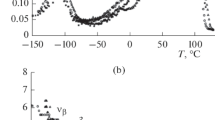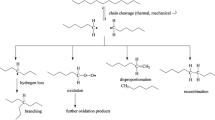Summary
Measurements of tanδ for polyethylene for frequencies around one kHz down to temperatures of 4.2° K show an increase in the dielectric loss (Fallou andBobo) (1). We have repeated these measurements with very sensitive equipment over a range of frequencies up to several kHz and down to temperatures of 1.2° K. We find maxima in tanδ as a function of temperature and frequency. It thus seems possible for there to be an activated mechanism at these very low temperatures. The values of the activation energy are of the order of only some cal/mol instead of the more usual kcal/mol. The loss peaks are observed in “as received” material, i. e. fabricated films and pressed plates. Additives and contaminations do not seem to play any role. The loss peaks are observed in stretched, particularly stretched crystalline, material. The dielectric losses vanish for melted and then slowly cooled or quenched material. Molecular rearrangements in the interface between crystalline and non-crystalline regions of the material may play a role in causing these losses.
Zusammenfassung
Messungen des tgδ von Polyäthylen mit Frequenzen bis zu einigen kHz und für Temperaturen bis herab zu 4,2° K zeigen einen Anstieg des dielektrischen Verlustes (Fallou undBobo) (1). Um zu sehen, ob dieses Verhalten real ist, wiederholten wir diese Experimente mit einer sehr präzisen Anordnung für Temperaturen bis herab zu 1,2° K. Wir finden Maxima für tgδ als Funktion der Temperatur, in der Lage abhängig von der Frequenz. So existieren also auch innerhalb des tiefsten Temperaturbereiches noch Möglichkeiten für aktivierte Mechanismen. Aus den experimentellen Daten ergeben sich Aktivierungsenergien der Größenordnungen von nur einigen cal/Mol, statt der üblicherweise bekannten kcal/Mol.
Die aktivierten Prozesse treten für Material im Lieferzustand „wie empfangen” auf. Das bedeutet, für Material verarbeitet zu Folien und zu gepreßten Platten. Zuschläge und Verunreinigungen dürften keine Rolle spielen, aber zum Beispiel ein Verstrecken. Höhere Kristallinität vergrößert den Verlust, nach Aufschmelzen und Abschrecken fallen die Verluste unter die Meßgrenze. Es gibt einige Gründe, daß die Molekülanordnung in den Bereichen zwischen Kristall und amorph eine wesentliche Rolle spielen.
Similar content being viewed by others
References
Fallou, B. andJ. C. Bobo Paper 3a, BEAMA Electrical Insulation Conference S. 197 (1971).
Huff, K. undF. H. Müller, Kolloid-Z. und Z. Polymere,153, 5 (1957).
Nielson, L. E., J. App. Physics25, 1209 (1954).
Grubler, M. G. andA. J. Kovacs, J. Poly. Sci.34, 551 (1959).
Swan, P. R., J. Poly. Sci.56, 403 (1962).
Armeniades, C. D. andE. Baer, J. Poly. Sci. A-2,9, 1345 (1971).
Yano, O. andY. Wada, J. Poly. Sci. A-2,9, 669 (1971).
McCammon, R. D., R. G. Saba, andR. N. Work, J. Poly. Sci. A-2,7, 1721 (1969).
Hara, T., M. Nozaki, andS. Okamota, Jap. J. App. Physics6, 1138 (1967).
Kosfeld, R. andU. v. Mylius Kolloid-Z. u. Z. Polymere250, 1088 (1972).
Phillips, P. J. G. Kleinheins, andR. S. Stein, to be published
Bares, J., Kolloid-Z. u. Z. Polymere239, 552 (1970).
Author information
Authors and Affiliations
Additional information
One of us(O. Heybey) thanks theAlexander-von-Humboldt-Stiftung for a fellowship which enabled him to carry out this work at the Institut für Polymere in Marburg.
We thankG. Knipsel for carrying out some of the measurements.
We thank the members of the shop, particularlyG. Strohriegl andH. Sprenger, for their help in constructing the apparatus.
Thanks, too, to theRöhm-Stiftung, for supporting our investigations in the polymer fields.
Rights and permissions
About this article
Cite this article
Heybey, O., Müller, F.H. Dielectric relaxation of polyethylene below 4° K. Kolloid-Z.u.Z.Polymere 251, 383–393 (1973). https://doi.org/10.1007/BF01498684
Received:
Issue Date:
DOI: https://doi.org/10.1007/BF01498684




